Ladywell Lodge
Dressington Avenue, Ladywell, SE13 7HT
Medical dates:
Medical character:
Chronic sick
In 1897 work began to build a
new workhouse for the St Olave's (Bermondsey) Union Board of Guardians.
It was not to be a workhouse as such, but an infirmary
intended solely to accommodate the elderly poor and infirm - an
innovative concept at the time.
The Ladywell workhouse, built on a large site which had once been the Slagrave farm, was officially opened in 1900 by the Prince and Princess of Wales. It had 812 beds. The workhouse was located at the south of the site, with the ancillary buildings to the north. The central administration block and dining hall were flanked either side by three double pavilion ward blocks. Four of the ward blocks were for the infirm, while six were for the healthy infirm and two for the healthy aged. The buildings were designed to provide the maximum light and space. The sexes were strictly segregated, with the men in the northern buildings and the women in the southern. A separate block had been built to accommodate six married couples. The site had its own water tower and also contained an isolation hospital, a laundry and two chapels - a Church of England one at the north and a Roman Catholic one at the south.
In 1904 St Olave's Union joined with St Margaret's to become the Bermondsey Union. The workhouse then became known as the Bermondsey Institution. By 1909 it have 1,000 beds.
During WW1 the Institution became the Bermondsey Military Hospital. It had 796 beds, of which 103 were for tuberculosis patients, 25 for isolation and 6 for dysentery cases.
In 1929, when the Boards of Guardians were abolished, the Institution came under the control of the L.C.C., who renamed it the Ladywell Institution.
During WW2 a parachute mine landed in the grounds at 02.40 in the morning of 20th September, 1940. It did not explode, but some 900 people had to be evacuated.
After 1940 the L.C.C. opened a nursery at 82 Ladywell Road, a detached block which had been built that year. The Ladywell Residential Nursery had cots for 150 infants. The Welfare Committee of the Institution ran it until 1952, when control of the Nursery passed to the L.C.C.'s Children's Committee.
The Institution did not join the NHS but continued in use as Ladywell Lodge, a residential home for the elderly managed by the L.C.C. It had the street address of 82 Ladywell Road.
It closed sometime around 1975.
Present status (May 2009)
Most of the buildings have been demolished. Ladywell Lodge, the water tower, the stables and the gatehouse remain. Most have been converted to residential use.
Most of the long narrow site has been progressively redeveloped for housing, divided into three estates - one small one at the southern corner, a larger one to the north by the former main entrance, and the largest in the centre occupying the main hospital site, now Dressington Avenue.
The Ladywell workhouse, built on a large site which had once been the Slagrave farm, was officially opened in 1900 by the Prince and Princess of Wales. It had 812 beds. The workhouse was located at the south of the site, with the ancillary buildings to the north. The central administration block and dining hall were flanked either side by three double pavilion ward blocks. Four of the ward blocks were for the infirm, while six were for the healthy infirm and two for the healthy aged. The buildings were designed to provide the maximum light and space. The sexes were strictly segregated, with the men in the northern buildings and the women in the southern. A separate block had been built to accommodate six married couples. The site had its own water tower and also contained an isolation hospital, a laundry and two chapels - a Church of England one at the north and a Roman Catholic one at the south.
In 1904 St Olave's Union joined with St Margaret's to become the Bermondsey Union. The workhouse then became known as the Bermondsey Institution. By 1909 it have 1,000 beds.
During WW1 the Institution became the Bermondsey Military Hospital. It had 796 beds, of which 103 were for tuberculosis patients, 25 for isolation and 6 for dysentery cases.
In 1929, when the Boards of Guardians were abolished, the Institution came under the control of the L.C.C., who renamed it the Ladywell Institution.
During WW2 a parachute mine landed in the grounds at 02.40 in the morning of 20th September, 1940. It did not explode, but some 900 people had to be evacuated.
After 1940 the L.C.C. opened a nursery at 82 Ladywell Road, a detached block which had been built that year. The Ladywell Residential Nursery had cots for 150 infants. The Welfare Committee of the Institution ran it until 1952, when control of the Nursery passed to the L.C.C.'s Children's Committee.
The Institution did not join the NHS but continued in use as Ladywell Lodge, a residential home for the elderly managed by the L.C.C. It had the street address of 82 Ladywell Road.
It closed sometime around 1975.
Present status (May 2009)
Most of the buildings have been demolished. Ladywell Lodge, the water tower, the stables and the gatehouse remain. Most have been converted to residential use.
Most of the long narrow site has been progressively redeveloped for housing, divided into three estates - one small one at the southern corner, a larger one to the north by the former main entrance, and the largest in the centre occupying the main hospital site, now Dressington Avenue.
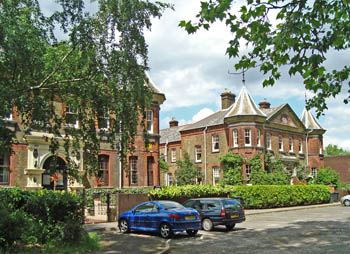
Ladywell Lodge, consisting of two symmetrical 2-storey buildings, was once the administration block and Superintendant's residence for the workhouse. It is now council-owned and has been converted into apartments.
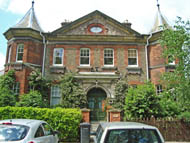
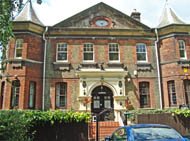
Both buildings have turrets in each corner of the eastern elevation.


The entrance to the left-hand building (left) and that to the right-hand one (right).
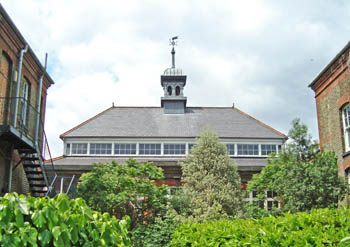
The administration buildings are connected by the former dining rooms of the workhouse. Until 2005 this building was used as the John Evelyn Education Centre, a branch of Abbey Manor College.
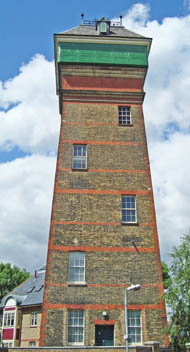
The former water tower, which was Grade II listed in 1990, has five storeys and is 120 feet (31 metres) high. It was refurbished in the late 1990s.
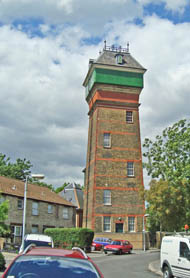
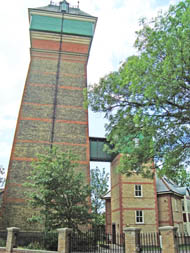
The water tower is now surrounded by new housing (right). The tower has been converted into six 1-bedroom apartments, with a modern 2-storey residential block with four 1-bedroom apartments connected to it by a high-level bridge (right).
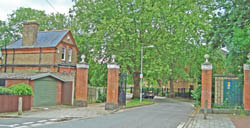

The original entrance to the workhouse on Malyons Terrace at the north of the site (right). The view up the original driveway, now Slagrove Place.
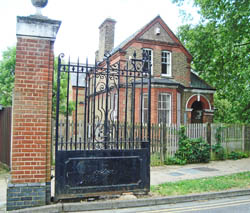
The gatehouse by the original entrance on Malyons Terrace. The original gates have been rehung on replica piers.
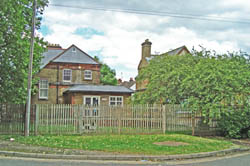
Lewisham Council's Ladywell Lodge Corporate Training Centre at No. 1 Slagrove Place, once the stables, have been sold recently (2011), together with the gatehouse, for £730,000.

Housing built around 1995 along Slagrove Place.
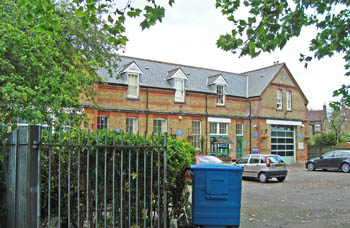
The Cherubins Day Nursery beside the gatehouse at the north of the site.
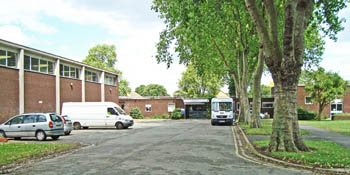
The Ladywell Centre, a day service for people aged 18 or over with disabilities and sensory impairments, is located in the centre of the site.
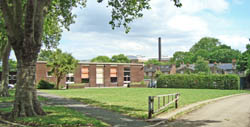
The Ladywell Centre with Lewisham Univerity Hospital seen in the background.

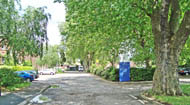
Housing on Dressington Avenue.
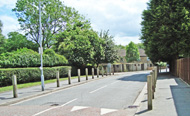
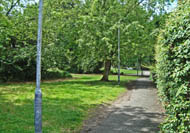
The current entrance off Dressington Avenue (left). The approach from the riverside on the east (right).
(Author unstated) 1900 Reflections from a Board Room mirror. Nursing Record and Hospital World, 26th May, 422.
(Author unstated) 1909 Nursing echoes. British Journal of Nursing, 26th June, 516.
(Author unstated) 1917 List of the various hospitals treating military cases in the United Kingdom. London, H.M.S.O.
http://collage.cityoflondon.gov.uk (1)
http://collage.cityoflondon.gov.uk (2)
http://collage.cityoflondon.gov.uk (3)
http://collage.cityoflondon.gov.uk (4)
http://councilmeetings.lewisham.gov.uk
http://edithsstreets.blogspot.com
http://hansard.millbanksystems.com (1)
http://hansard.millbanksystems.com (2)
www.25throyalfusiliers.co.uk
www.britishlistedbuildings.co.uk
www.geograph.org.uk (1)
www.geograph.org.uk (2)
www.heritage-explorer.co.uk
www.ideal-homes.org.uk (1)
www.ideal-homes.org.uk (2)
www.ideal-homes.org.uk (3)
www.london-footprints.co.uk
www.prints-online.com
www.raf.mod.uk
www.scienceandsociety.co.uk
www.workhouses.org.uk
Return to home page